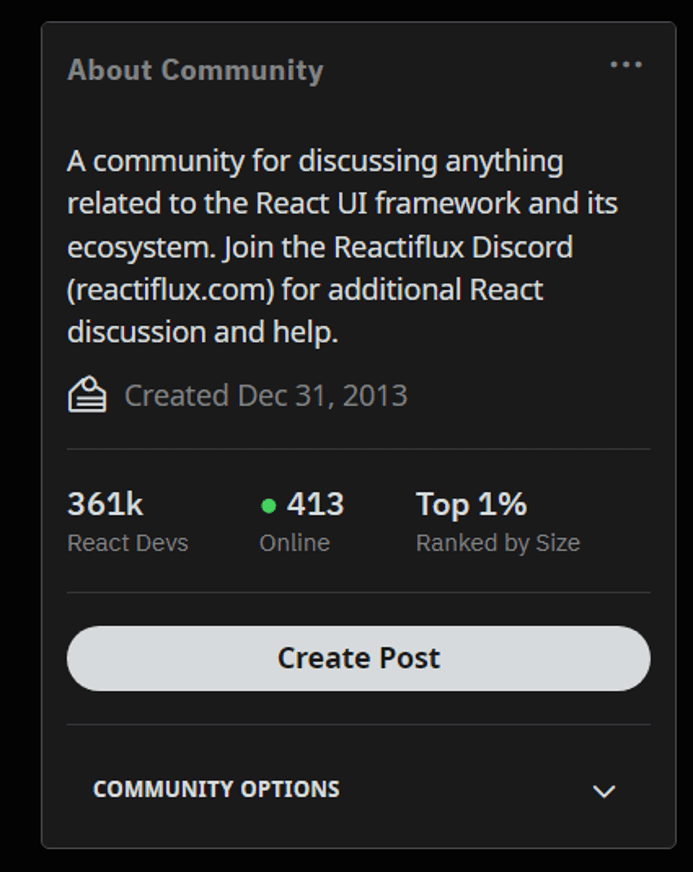Introduction to ReactJS
ReactJS, officially known as React.js, was first released by Facebook (now Meta) in 2013 and is currently maintained by a dedicated team of developers and the general public – an indirect way of saying it’s not going anywhere.
Its biggest value lies in its ability to deploy apps across multiple platforms and devices using the same codebase, leading to the moniker ‘learn once, use everywhere’.
Whether that means developers are efficient or just plain lazy is up for debate.

Either way, ReactJS is one of the most widely adopted JavaScript libraries in the world today, and an excellent choice for many cross-platform app development projects.
The significance of ReactJS in modern web development
There are several key factors that help make ReactJS among the most important frontend builders in the modern-day web development landscape, as the table below will show.
| Factor | Description | |
| 1 | Efficiency | Quick load times, smooth user interactions, and an overall enhanced performance. |
| 2 | Versatility | Caters to all kinds of projects – from simple single-page apps to complex web portals. |
| 3 | UX | Developers can create highly interactive user interfaces easily, promoting superb user experience. |
| 4 | Speed | Component-based architecture promotes code reusability and increases development speed. |
Of course, it is not the only contender, and there is no one perfect solution to every use case.
For that reason, this guide will provide you with a thorough understanding of ReactJS and allow you to decide if it is the right frontend solution for your web development project in 2024.
The ‘building blocks’ of ReactJS
ReactJS is a popular JavaScript library used for building user interfaces, particularly for single-page applications (though it is capable of much more). It allows developers to easily create reusable UI components thanks to its core fundamentals:
Components
ReactJS is all about components. These are self-sustaining, independent micro-entities that describe a part of the user interface. Components facilitate code reusability and division of the UI into manageable pieces.
JSX
JSX, or JavaScript XML, is a syntax extension for JavaScript. It isn’t necessary to use ReactJS, but it’s recommended because it simplifies the code and enhances readability. With JSX, HTML-like syntax can be used in your JavaScript codes.
Virtual DOM
ReactJS introduced the concept of Virtual DOM to enhance performance. It creates a copy of the actual DOM and works with this copy for any changes. If there’s a change in the state of an object, it only updates that particular object in the real DOM, instead of updating all the objects.
Props
Props, or Properties, in ReactJS allow components to interact with each other. Data is passed from parent to child components through props.
State
State in ReactJS is an object that contains data about components that should render. Whenever the state changes, the component re-renders.
Simply put, ReactJS provides a simple and efficient way to build User Interfaces by means of a dynamic and high-performance environment. Its focus on individual components enhances code reuse and simplifies debugging.
ReactJS history and evolution
ReactJS, also frequently referred to as React started back in 2011 when Facebook was struggling with code maintenance issues due to the staggering amount of user data.
To counter this challenge, Facebook engineer Jordan Walke developed an innovative Javascript library – the one we now know as ReactJS, in 2011.
In 2013, Facebook decided to open-source ReactJS to unfold its potential.
The move was well received, and many developers contributed to enhance the library.
Since its launch, ReactJS has continued to grow and improve. Let’s look at some recent key updates:
ReactJS key updates in 2022
- React Server Components: A major update aimed at improving the performance of React applications. This allows developers to write components that render directly on the server, reducing the size of JavaScript bundle that’s sent to the client.
- Concurrent Mode: This new mode makes your React apps faster and more responsive by rendering changes to the user interface in memory, displaying them to the user only when it’s ready.
- React Fast-refresh: This enhancement boosts the developer experience by automatically updating the interface as you work on your code.
ReactJS key updates in 2023
- Improved Error Handling: The update allows React to recover from errors in an unmounted tree without unmounting the entire app.
- React Flight: This is a new method for server rendering. It allows components to be sent to the client and rendered while still loading, leading to a quicker initial load time.
- Suspense List: Enables developers to manage how loading states propagate through a React component tree, which helps in improving performance and UI consistency.
ReactJS’s new features and enhancements of 2022 and 2023 demonstrate a deliberate movement towards optimizing web application performance, a characteristic vital for your project’s success.
Advantages of choosing ReactJS For Web Development
React Virtual DOM
The virtual DOM is a simulation of the actual DOM. Whenever a change occurs in your application, it first happens in this virtual space. By doing this, React ensures only the necessary parts of the original DOM get updated, and not the whole tree.
The virtual DOM allows React to keep track of changes in real time without burdening the browser with unnecessary tasks. This results in smoother and faster updates and significantly boosts your app’s performance.
Superior performance vs other frameworks and libraries
| Framework / Library | Processing Speed | Resource Consumption | Complexity level |
| ReactJS | High | Low | Moderate |
| Angular | Moderate | Moderate | High |
| Vue | High | Low | Low |
With its virtual DOM, ReactJS guarantees high processing speed and low resource consumption, even in complex applications.
While Angular and Vue are valid choices, here are the main drawbacks of each compared to ReactJS:
- Compared to ReactJS, Angular has slower performance.
- Compared to ReactJS, Vue has larger API surface areas which increase attack surface and maintenance requirements.
We’d argue that this makes the overall performance difference between ReactJS and other popular frameworks quite distinct.
Reusable components
Components are independent and reusable bits of code that serve the same purpose as JavaScript functions. This is a significant benefit for developers as it promotes code recyclability and efficient development approaches.
The ability to write once and reuse the code across various parts of an application, means the code base is often cleaner, the user experience more consistent, and maintenance / updates can be carried out rapidly at the component level.
An active React community
When choosing a technology for your web development project, an active community of developers implies a network of support, growth, and continuity. On this front, the ReactJS community does not disappoint.

When we talk about the React community, it goes beyond just an essential developer base.
- Knowledge base: With seasoned developers sharing tutorials, documents, guides as part of open source contribution, it enables learning from real-life problem-solving approaches.
- Community support: Regular meetups, workshops, conferences, and forums conducted both online and offline foster direct interaction, knowledge exchanges, and networking.
- Continuous updates: The active community implies continuous updates and improvements, ensuring the technology is always up-to-date to meet the evolving needs of the developers and the market.
- Problem-solving forums: Active forums like Stack Overflow are filled with queries, solution threads, and discussions related to React. It’s a great way not just for problem-solving but also to remain updated with typical challenges and solutions.
When it comes to developing your web project, choosing the right technology stack can be crucial. Among many tools and technologies, ReactJS stands out for numerous reasons, and a prominent one is its extensive array of third-party libraries and tools. These resources can extensively simplify your web development process and aid in creating stunning, functional projects more efficiently.
Third-party libraries and tools
Third-party libraries and tools are pre-written code that developers can use in their projects. These resources can save developers from rewriting common functions, significantly improving productivity.
Here are just some of the most popular third-party libraries and tools that significantly aid the ReactJS development community:
| Library/Tool | Description |
| Redux | Helps manage the state of your React application in a more predictable way. |
| React-Router | Provides seamless routing for your React applications, making page transitions smooth and simple. |
| Material-UI | A set of React components that implement Google’s Material Design. |
Popular alternatives to ReactJS
While ReactJS holds a distinct place in web development, it’s important to acknowledge other popular frontend frameworks. These include Angular and Vue.js.
Angular
Developed and maintained by Google, Angular is a powerful, open-source web application framework. It allows developers to build large-scale and high-performance web applications.
- Pros: It is well-equipped with productive and fully featured CLI and integrated practices, and supports Typescript for developing large-scale applications.
- Cons: However, it has a steeper learning curve than other frameworks due to its comprehensive list of features.
Vue.js
Another strong contender in the world of frameworks is Vue.js. Regarded for its simplicity, Vue.js offers a progressive framework that scales between a library and a full-featured framework.
- Pros: Its biggest strengths are its simplicity, flexibility, and performance, which makes it easy for beginners to pick up and makes development smooth.
- Cons: On the downside, it lacks a dedicated company’s support which could be a concern when opting for long-term projects.
Check out the following comparison table for a more detailed look:
| Feature | ReactJS | Alternatives |
| Learning Curve | ReactJS has a certain learning curve. However, its community is massive, which means there are a lot of plugins created and issues resolved. | Other frameworks might have a lower learning curve, but they might not offer as large a community as ReactJS. |
| Data Flow | ReactJS adopts a unidirectional data flow, which makes tracking changes and debugging the code more efficient. | Frameworks with bidirectional data flow can present difficulties in managing the state of larger applications. |
We don’t want to drown this post in technical details that don’t really matter, so allow us to cut to the chase: often times it comes down to what framework developers are comfortable with.
Say you have two developers using two different frameworks to build a similar app.
Provided each is equally experienced with their framework of choice, you will probably get similar satisfactory results.
Matching project requirements to your tech stack
The process of selecting a tech stack for your project is not one to be taken lightly, as choosing the wrong technology can lead to unnecessary complications, delays, and potentially even failure. Therefore, it is of paramount importance to align your technology choices with the project’s goals.
When choosing ReactJS for your web development project, a key factor to consider is the type of project you are working on. Let’s dive into some examples:
E-commerce
An e-commerce project typically involves handling a wide range of data from product information to customer transactions. With ReactJS, you can build fast and interactive user interfaces that can handle this complexity.
- Benefits: ReactJS is great for updating and rendering components dynamically which is essential for any e-commerce site, where product data changes frequently.
- Drawbacks: While ReactJS can significantly improve the speed and performance of your e-commerce application, it does require initial investment in terms of learning and understanding the technology.
Social Media
A social media application involves not just a lot of data but real-time updates as well. ReactJS, with its virtual DOM, is highly efficient and can handle the rapid render changes required by a social media project.
- Benefits: The real-time data handling capability of ReactJS makes it suitable for social media applications where updates are constant and instantaneous.
- Drawbacks: While ReactJS provides excellent efficiency when it comes to rendering changes, complex state management might require external libraries.
Website Builders
A website builder is a tool that helps you construct a website. This tool is particularly beneficial for those lacking a technical background as it allows for the creation of websites without the need to code. .
- Benefits: ReactJS can create dynamic and interactive user interfaces for website builders. Its component-based structure allows developers to reuse components, thereby speeding up the development process and improving the performance of the website builder.
- Drawbacks: Though ReactJS can provide more interactive UIs for website builders, getting started might be challenging for beginners due to its steep learning curve.
Learning Management Systems (LMS)
The primary purpose of an LMS is to host and deliver digital learning content, track student or employee performance, and manage communication among all participants. An LMS is often packed with a variety of features that can make education and training more engaging and effective. These can include quizzes, forums, interactive content, and progress tracking among many others.
- Benefits: Learning Management Systems benefit greatly from ReactJS due to its efficiency and scalability. It has the capabilities to manage high-traffic sites, making it an excellent choice for educational platforms that see a surge in user activity, especially during peak learning times.
- Drawbacks: For smaller scale Learning Management Systems, ReactJS might be overly sophisticated. If your site does not need continuous content updates, a less complex technology might be more fitting.
From the above, we can see that ReactJS is a versatile tool that can accommodate various project types. This comes down to two major factors: scalability and long-term maintenance.
ReactJS and scalability
Scalability in the context of software development refers to the ability of a program to grow in size and complexity to meet a growing user base or data volume. In simpler terms, a scalable project is one that continues to perform well as it expands.
ReactJS is known for its ability to handle large, complex projects efficiently thanks to its component-based architecture and efficient rendering through its virtual DOM.
However, ReactJS is not a one-size-fits-all solution. There are some cases where ReactJS might not be the best fit for scalability.
- Overhead complications: The complexity introduced by the component-based architecture may outweigh the benefits for smaller projects.
- Lack of in-built state management: For projects that require complex state management, you may need to integrate additional libraries such as Redux or MobX, adding another layer of complication.
ReactJS and long-term maintenance / updates
With ReactJS, long-term maintenance and updates are made significantly easier, thanks to its solid developer community, abundant resources, and ease of onboarding new collaborators to existing large-scale projects.
Perhaps most importantly, as ReactJS is a project supported by Meta, it has tremendous support behind it that ensures it will continue to evolve with the times and adopt current best practices.
Successful ReactJS Use Cases
ReactJS has been adopted by numerous companies across various industries, significantly improving their web development efficiency and user experience. Here are some of our favourite examples:
Productivity: Dropbox

Dropbox is a leading file hosting service that offers cloud storage, file synchronization, personal cloud, and client software. Dropbox uses ReactJS to build user interfaces, with reusable components making the app’s UI more consistent and easier to maintain.
Media: New York Times

Did you know that one of the world’s most-read newspapers The New York Times runs on ReactJS? This sophisticated and user-centric digital platform makes use of the versatile capabilities offered by ReactJS to deliver high-quality content swiftly and efficiently to its millions of readers globally. They’ve got terrible taste in fonts but excellent taste in development frameworks.
Sales: Salesforce

The global customer relationship management (CRM) leader employs ReactJS in their web development projects. ReactJS offers a flexible, efficient, and declarative JavaScript framework, qualities which align seamlessly with Salesforce’s commitment to providing excellent services to its clients.
Social Media: Reddit

Reddit primarily uses ReactJS for its most dynamic and complex features. ReactJS provides efficient and smooth performance. This is crucial for Reddit, given the vast amount of user-generated content it needs to handle smoothly and swiftly.
PS. Lots of Upstackers are also active lurkers on Reddit.
Common ReactJS Challenges Faced By Web Developers
It’s no secret that ReactJS, while a powerful tool, comes with a set of unique challenges for developers both seasoned pros or those just starting out. Thankfully, these challenges are well-known and have simple solutions.
| Challenges | Description | Solution |
| Steep Learning Curve | ReactJS boasts a plethora of features that, especially for developers new to the framework, might be overwhelming. The concepts like Virtual DOM, JSX, and state management, and the fact that JavaScript knowledge alone doesn’t suffice can all be daunting. | Partitioning the learning process. Start by understanding the basics, gradually introducing the advanced concepts. Online resources, tutorials, and podcasts are also beneficial. |
| Poor Quality Documentation | While the ReactJS community is robust and active, the quality of provided documentation often lags. Developers might face issues while trying to understand certain functions or features, possibly leading to delays in project completion. | Investing time in utilization of other resources like online forums, blogs, and discussion groups can help. Reaching out to the ReactJS community for specific queriesis also recommended. |
| Frequent Updates | ReactJS is known for its frequent updates. While generally a sign of an active framework, these updates can be challenging to keep up with, causing possible interruption in the development cycle. | Having a dedicated person or team to track updates could help manage these challenges effectively. This will ensure the team stays informed about the latest changes, allowing for timely implementation of updates. |
ReactJS in 2023: React Server Components
React Server Components are an all-new feature of React that opens the way for more powerful ways to build web applications. Let us dig deeper into this concept and look at what it can offer.
Unlike traditional React Components, which run on the client-side, React Server Components execute on the server. The server renders these components, creates the resulting HTML, and sends it to the client. Consequently, it greatly reduces the amount of JavaScript that runs on the client side.
Key Features of React Server Components
| Features | React Server Components | Traditional React Components |
| Executed on | Server | Client |
| Impact on Bundle Size | No Impact | Increases with the complexity of components |
| Access to Back-end resources | Direct | Via API calls |
Impact on frontend development
React Server Components, a revolutionary feature of ReactJS, offers improvements in both user experience (UX) and performance in web development projects.
Enhanced User Experience (UX)
By handling heavier computations on the server-side, it lightens the load on the client-side, ensuring a smoother, lag-free interaction for the users. Developers also have greater flexibility to incorporate a wider range of features into their applications. This can lead to a richer, more interactive user experience.
Improved Performance
React Server Components server-side rendering reduces the size of JavaScript bundles, thus reducing page load times, which in turn enhances the responsiveness of the website and improves overall performance.
Conclusion: ReactJS is (probably) exactly what you need
We’ve analyzed its uses, benefits, and the vast scope it can provide for your project’s growth.
Before we wrap up, let’s recap why ReactJS is an excellent addition to a web development tech stack:
- Efficiency: ReactJS allows developers to reuse code components, promoting a smoother development process and reducing the time spent on writing redundant code.
- Performance: With its virtual DOM, ReactJS offers superior performance. It minimizes updates and patching to the real DOM, making your web app operate faster and delivering a smoother user experience.
- Flexibility: ReactJS is not confined to one realm. It is used in both web and mobile application development, giving your project a broad spectrum of capabilities.
- Community support: Being backed by Meta, ReactJS has a robust online community. Therefore, it’s relatively easy for developers to find solutions, tutorials, and advice if they encounter any issues.
- Future-proof: Rather than diminishing, the popularity of ReactJS seems to be growing, making it a safe long-term choice for your web development needs.
- Easy to learn: Compared to other frameworks, ReactJS’s learning curve is relatively gentle, making it an accessible choice for teams with diverse levels of experience.
What’s Next?
Time for research! When considering a new technical tool, it’s equally crucial to be mindful of its alternatives.

We strongly advocate doing due diligence and gaining a basic understanding of several popular frontend web application builders so you can make a truly informed choice – in which case, you’ll want to engage app developers with the necessary experience.








